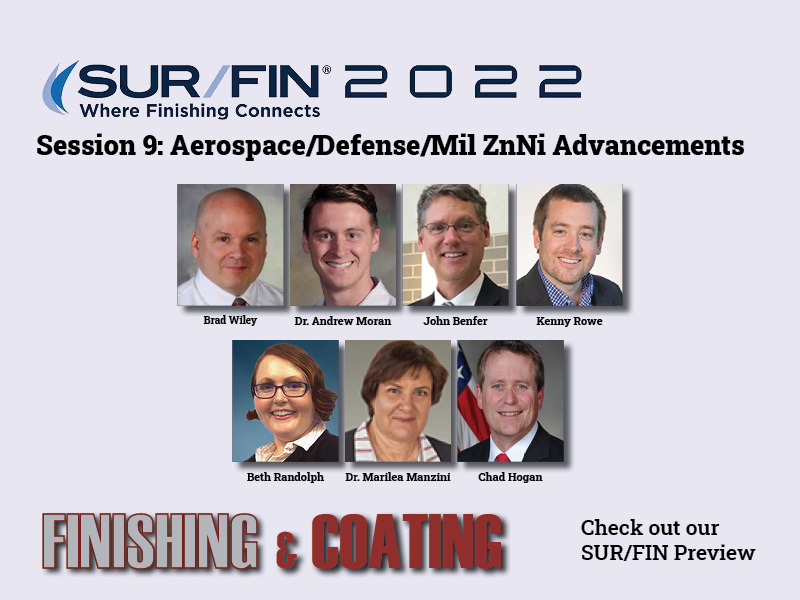Session 9 at the NASF SUR/FIN Technical Conference will be on “Aerospace/Defense/Military Zinc Nickel Advancements.”
Here are the abstracts for the presentations on June 8. Please visit www.nasfsurfin.com for information on registering for the event:
Session 9: Aerospace/Defense/Military Zinc Nickel Advancements
Chairs Dr. Keith Legg, Rowan Technology, and Brad Wiley, Rolls Royce
8:30 – 9:00: Zinc Nickel Plated Structure: Key Process Variables and DoE — Brad Wiley, Rolls-Royce
 Brad WileyThe aerospace industry has long sought a non-toxic replacement for Cadmium plating. This presentation provides a technical analysis of the variables affecting Zinc-Nickel plating's structure. Cadmium plating is a high performance protection layer for steels. It exhibits corrosion protection in extreme environments as well as provides other advantageous properties such as low friction, conductivity, and freedom from voluminous white precipitates. However, Cadmium plating and its traditional hexavalent-chromium-containing post-plate passivation are toxic and banned by many country's environmental laws. Zinc-Nickel, with its Cobalt free passivation treatment, is a high performance, environmentally acceptable alternate to Cadmium plating. Due to risks of hydrogen embrittlement, Zinc-Nickel cannot utilize brighteners and, as such, exhibits a variation in microstructure, visual appearance, and uneven uptake of its passivation treatment. This presentation will provide a summary of the work to understand the variables which contribute to this variation and the results of a full factorial design of experiments (DoE) to characterize their impact. Further, data will be presented on the properties of the output of this DoE including corrosion resistance.
Brad WileyThe aerospace industry has long sought a non-toxic replacement for Cadmium plating. This presentation provides a technical analysis of the variables affecting Zinc-Nickel plating's structure. Cadmium plating is a high performance protection layer for steels. It exhibits corrosion protection in extreme environments as well as provides other advantageous properties such as low friction, conductivity, and freedom from voluminous white precipitates. However, Cadmium plating and its traditional hexavalent-chromium-containing post-plate passivation are toxic and banned by many country's environmental laws. Zinc-Nickel, with its Cobalt free passivation treatment, is a high performance, environmentally acceptable alternate to Cadmium plating. Due to risks of hydrogen embrittlement, Zinc-Nickel cannot utilize brighteners and, as such, exhibits a variation in microstructure, visual appearance, and uneven uptake of its passivation treatment. This presentation will provide a summary of the work to understand the variables which contribute to this variation and the results of a full factorial design of experiments (DoE) to characterize their impact. Further, data will be presented on the properties of the output of this DoE including corrosion resistance.
9:00 – 9:30: Direct Brush-Plating Electrodeposition of ZnNi Coatings on Al 2219 By One-Step Pretreatment — Dr. Andrew Moran, Faraday Technology
 Dr. Andrew MoranZnNi is useful as a hard protective corrosion inhibiting coating for aluminum alloys. In this presentation, we will discuss recent work on the development of a one-step surface pretreatment for the brush electrodeposition of LHE alkaline ZnNi coatings on Al 2219. Coating of the aluminum commonly requires extensive and specialized surface pretreatment processes (such as zincate and electrolysis NiP application) prior to deposition, owing to aluminum’s reactive nature and affinity for oxygen. By leveraging pulse-reverse current application, Faraday’s process can employ a neutral and environmentally benign pretreatment electrolyte within a brush-plating system for field applications of ZnNi deposition on Al surfaces.
Dr. Andrew MoranZnNi is useful as a hard protective corrosion inhibiting coating for aluminum alloys. In this presentation, we will discuss recent work on the development of a one-step surface pretreatment for the brush electrodeposition of LHE alkaline ZnNi coatings on Al 2219. Coating of the aluminum commonly requires extensive and specialized surface pretreatment processes (such as zincate and electrolysis NiP application) prior to deposition, owing to aluminum’s reactive nature and affinity for oxygen. By leveraging pulse-reverse current application, Faraday’s process can employ a neutral and environmentally benign pretreatment electrolyte within a brush-plating system for field applications of ZnNi deposition on Al surfaces.
9:30 – 10:00: Naval Aviation Transition of Zinc-Nickel Electroplate for High Strength Steel Applications — John Benfer, Naval Air Station Jacksonville
 John BenferNaval Air Systems Command (NAVAIR) has recently approved zinc-nickel electroplating as a substitute to cadmium electroplating for high strength steel components commonly associated with landing and arresting gear systems. The qualification effort required a testing program to characterize coating quality, corrosion performance and structural mechanical properties. This data resulted in the development of a new military specification (MIL-PRF-32660) for engineering design. This presentation will discuss material properties, processing, tooling and infrastructure requirements to transition this technology to DoD, OEM and industry manufacturing, repair and overhaul (MRO) facilities for improved coating performance and durability.
John BenferNaval Air Systems Command (NAVAIR) has recently approved zinc-nickel electroplating as a substitute to cadmium electroplating for high strength steel components commonly associated with landing and arresting gear systems. The qualification effort required a testing program to characterize coating quality, corrosion performance and structural mechanical properties. This data resulted in the development of a new military specification (MIL-PRF-32660) for engineering design. This presentation will discuss material properties, processing, tooling and infrastructure requirements to transition this technology to DoD, OEM and industry manufacturing, repair and overhaul (MRO) facilities for improved coating performance and durability.
10:00 – 10:30: Selective Aluminum Anodize and Zinc-Nickel Surface Finishing Technology — Kenny Rowe, Naval Air Systems Command
 Kenny RoweAnodizing is a surface finishing process used to increase the thickness, corrosion protection, and wear of a natural oxide layer on the surface of aluminum. Selective anodize allows an area to be anodized without full tank immersion. This is beneficial due to reduced cost, TAT, and the ability to apply or repair an anodic coating without disassembly. The largest set back with the selective anodize process has been the need for a flow-through cathode as well as electrolyte temperature control requirements. These setbacks led to the design of selective electroplating technology improvements (SETI) performed under a recently completed small business innovative research (SBIR) project. Similar needs exist for recently NAVAIR-qualified zinc-nickel electroplating processes. NAVAIR has initiated a new SBIR project to certify zinc-nickel selective repair technologies. This SBIR will focus on optimizing corrosion, hydrogen embrittlement, and fatigue performance testing. This maintenance technology capability benefits fleet and depot level maintainers for the localized repair of existing zinc- nickel or cadmium coatings. The development and integration of zinc-nickel brush electroplating will play a key role in continuing the reduction of toxic chemicals such as cadmium and hexavalent chromium.
Kenny RoweAnodizing is a surface finishing process used to increase the thickness, corrosion protection, and wear of a natural oxide layer on the surface of aluminum. Selective anodize allows an area to be anodized without full tank immersion. This is beneficial due to reduced cost, TAT, and the ability to apply or repair an anodic coating without disassembly. The largest set back with the selective anodize process has been the need for a flow-through cathode as well as electrolyte temperature control requirements. These setbacks led to the design of selective electroplating technology improvements (SETI) performed under a recently completed small business innovative research (SBIR) project. Similar needs exist for recently NAVAIR-qualified zinc-nickel electroplating processes. NAVAIR has initiated a new SBIR project to certify zinc-nickel selective repair technologies. This SBIR will focus on optimizing corrosion, hydrogen embrittlement, and fatigue performance testing. This maintenance technology capability benefits fleet and depot level maintainers for the localized repair of existing zinc- nickel or cadmium coatings. The development and integration of zinc-nickel brush electroplating will play a key role in continuing the reduction of toxic chemicals such as cadmium and hexavalent chromium.
10:30 – 11:00: Advanced Brush ZnNi and Sulfuric Acid Anodize Processing — Beth Randolph, Engineering and Software System Solutions (ES3)
 Beth RandolphES3 has successfully completed Phase I and II SBIR efforts confirming three (3) low hydrogen embrittlement (LHE) alkaline zinc-nickel brush plating solutions are viable brush Cd alternatives, validating the solutions by testing such as quality, thickness, adhesion, corrosion, and hydrogen embrittlement. Likewise, ES3 successfully completed a Phase I SBIR effort that investigated/developed spot/brush anodize chemistry alternatives for aircraft applications that has now moved straight into Phase III on aircraft component applications for the US Air Force that are in-service. Both efforts developed advanced processing techniques to ensure controlled chemical composition of the as plated coatings. Additionally, these efforts included the design of a cleaner, dripless system that can cover small and large surface areas. The goal of implementing brush Zn-Ni and SAA chemistries and the dripless systems is to reduce or eliminate brush Cd and CAA and to maintain a cleaner environment when doing brush Zn-Ni and brush anodize repairs. ES3 will further validate the brush Zn-Ni and SAA anodize chemistries to ensure they meet requirements with the dripless system on additional substrate types and additional aircraft airworthiness requirements as identified by the US Air Force, Navy and Army.
Beth RandolphES3 has successfully completed Phase I and II SBIR efforts confirming three (3) low hydrogen embrittlement (LHE) alkaline zinc-nickel brush plating solutions are viable brush Cd alternatives, validating the solutions by testing such as quality, thickness, adhesion, corrosion, and hydrogen embrittlement. Likewise, ES3 successfully completed a Phase I SBIR effort that investigated/developed spot/brush anodize chemistry alternatives for aircraft applications that has now moved straight into Phase III on aircraft component applications for the US Air Force that are in-service. Both efforts developed advanced processing techniques to ensure controlled chemical composition of the as plated coatings. Additionally, these efforts included the design of a cleaner, dripless system that can cover small and large surface areas. The goal of implementing brush Zn-Ni and SAA chemistries and the dripless systems is to reduce or eliminate brush Cd and CAA and to maintain a cleaner environment when doing brush Zn-Ni and brush anodize repairs. ES3 will further validate the brush Zn-Ni and SAA anodize chemistries to ensure they meet requirements with the dripless system on additional substrate types and additional aircraft airworthiness requirements as identified by the US Air Force, Navy and Army.
11:00 – 11:30: Chromate-Free Primer Using Ecosky Pigment for ZnNi Plated High-Strength Steel — Dr. Marilea Manzini, Collins Aerospace
 Dr. Marilea ManziniThis presentation will describe the identification and development of a new class of corrosion inhibitive pigment for use in organic coatings for the protection of zinc nickel plated steel and the results of testing to date. This new primer; which is VOC and REACh compliant, can substitute chromate primers without any compromise on corrosion resistance. Aerospace materials are undergoing an accelerated evolution to meet new marketplace and regulatory restrictions on hazardous materials, including the elimination of chromates (Cr 6+) from all chemical processes utilized currently in industry. In the area of high strength steel structures, considerable progress has been made in the development and qualification of zinc nickel protective plating to replace cadmium and titanium-cadmium plating systems. While these new alloy plating technologies fulfill their requirements for protection of the underlying steel, the zinc nickel plating itself requires a compatible organic finish to deliver the full set of requirements for the component. It is known that most of existing aerospace primers have chromates in their composition. Commercial chromated free primers exist but have a marginal performance when used over high strength steel and Zn-Ni plating. This introduces significant risk of corrosion for the aerospace industry and for on landing gears in particular. Our work describes the identification and development of a new class of corrosion inhibitive pigment for use in organic coatings for the protection of zinc nickel plated steel, and the results of testing to date. This new primer which is VOC and REACh compliant can substitute chromate primers without any compromise on corrosion resistance.
Dr. Marilea ManziniThis presentation will describe the identification and development of a new class of corrosion inhibitive pigment for use in organic coatings for the protection of zinc nickel plated steel and the results of testing to date. This new primer; which is VOC and REACh compliant, can substitute chromate primers without any compromise on corrosion resistance. Aerospace materials are undergoing an accelerated evolution to meet new marketplace and regulatory restrictions on hazardous materials, including the elimination of chromates (Cr 6+) from all chemical processes utilized currently in industry. In the area of high strength steel structures, considerable progress has been made in the development and qualification of zinc nickel protective plating to replace cadmium and titanium-cadmium plating systems. While these new alloy plating technologies fulfill their requirements for protection of the underlying steel, the zinc nickel plating itself requires a compatible organic finish to deliver the full set of requirements for the component. It is known that most of existing aerospace primers have chromates in their composition. Commercial chromated free primers exist but have a marginal performance when used over high strength steel and Zn-Ni plating. This introduces significant risk of corrosion for the aerospace industry and for on landing gears in particular. Our work describes the identification and development of a new class of corrosion inhibitive pigment for use in organic coatings for the protection of zinc nickel plated steel, and the results of testing to date. This new primer which is VOC and REACh compliant can substitute chromate primers without any compromise on corrosion resistance.
11:30 – 12:00: Alternate Method of Surface Activation of High-Strength Steel for Electroplating — Chad Hogan, U.S.A.F.
 Chad HoganLanding gear platings, such as low hydrogen embrittlement (LHE) zinc-nickel (Zn-Ni), and cadmium (Cd) are designed to protect the base material from the environmental effect of field use. Inherent to the electroplating process is the introduction of hydrogen into the high strength steel (HSS) aircraft components, which can cause hydrogen embrittlement (HE). Currently, the plating processes are followed by hydrogen embrittlement (HE) relief bake for a minimum of 23 hours at 375°F +/-25°F. During the testing efforts, USAF/ES3 demonstrated that it is feasible to reduce the bake time required to remove hydrogen absorbed during the electroplating processes from HSS landing gear components. Initial testing was conducted on ASTM F519 coupons consisting of 4340 air melt HSS to provide acceptable test points for additional material tests to verify hydrogen bake out. Additional testing was conducted, using various coupon geometries and test methods from ASTM F519, to ensure that the reduction in process functions and performs to acceptable standards. The test results validated the potential of reduction of HE relief bake to times significantly less than the traditional 23 hours. Additional scale-up testing must be accomplished to validate the coupon test data before a reduced HE relief bake time can be implemented. Decreased bake times would result in significant reductions in USAF overhaul workflow times, energy usage, depot process inventory, and new spares costs. Additionally, the reduced processing time will lead to significant cost savings for the USAF and industry.
Chad HoganLanding gear platings, such as low hydrogen embrittlement (LHE) zinc-nickel (Zn-Ni), and cadmium (Cd) are designed to protect the base material from the environmental effect of field use. Inherent to the electroplating process is the introduction of hydrogen into the high strength steel (HSS) aircraft components, which can cause hydrogen embrittlement (HE). Currently, the plating processes are followed by hydrogen embrittlement (HE) relief bake for a minimum of 23 hours at 375°F +/-25°F. During the testing efforts, USAF/ES3 demonstrated that it is feasible to reduce the bake time required to remove hydrogen absorbed during the electroplating processes from HSS landing gear components. Initial testing was conducted on ASTM F519 coupons consisting of 4340 air melt HSS to provide acceptable test points for additional material tests to verify hydrogen bake out. Additional testing was conducted, using various coupon geometries and test methods from ASTM F519, to ensure that the reduction in process functions and performs to acceptable standards. The test results validated the potential of reduction of HE relief bake to times significantly less than the traditional 23 hours. Additional scale-up testing must be accomplished to validate the coupon test data before a reduced HE relief bake time can be implemented. Decreased bake times would result in significant reductions in USAF overhaul workflow times, energy usage, depot process inventory, and new spares costs. Additionally, the reduced processing time will lead to significant cost savings for the USAF and industry.



































